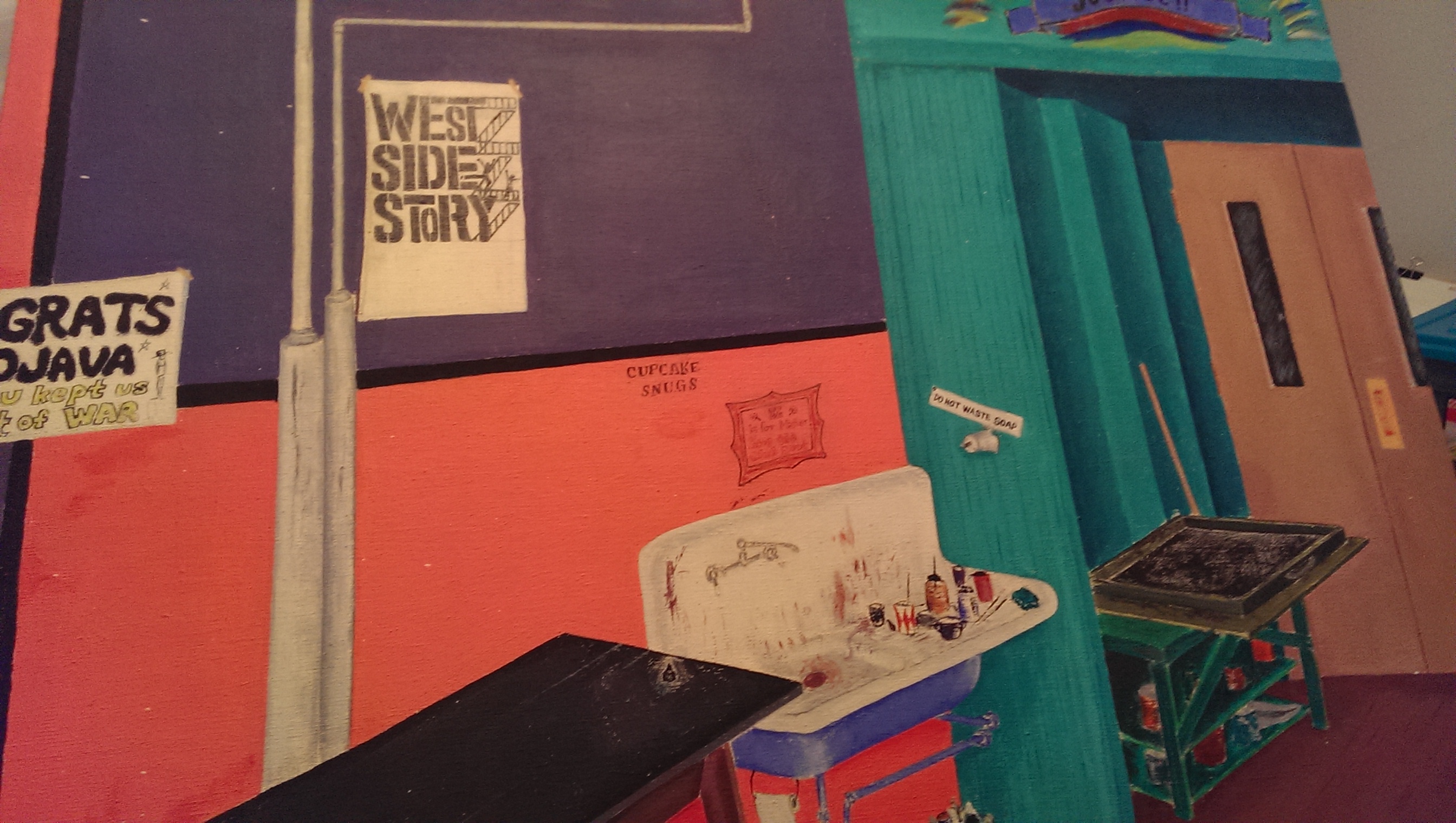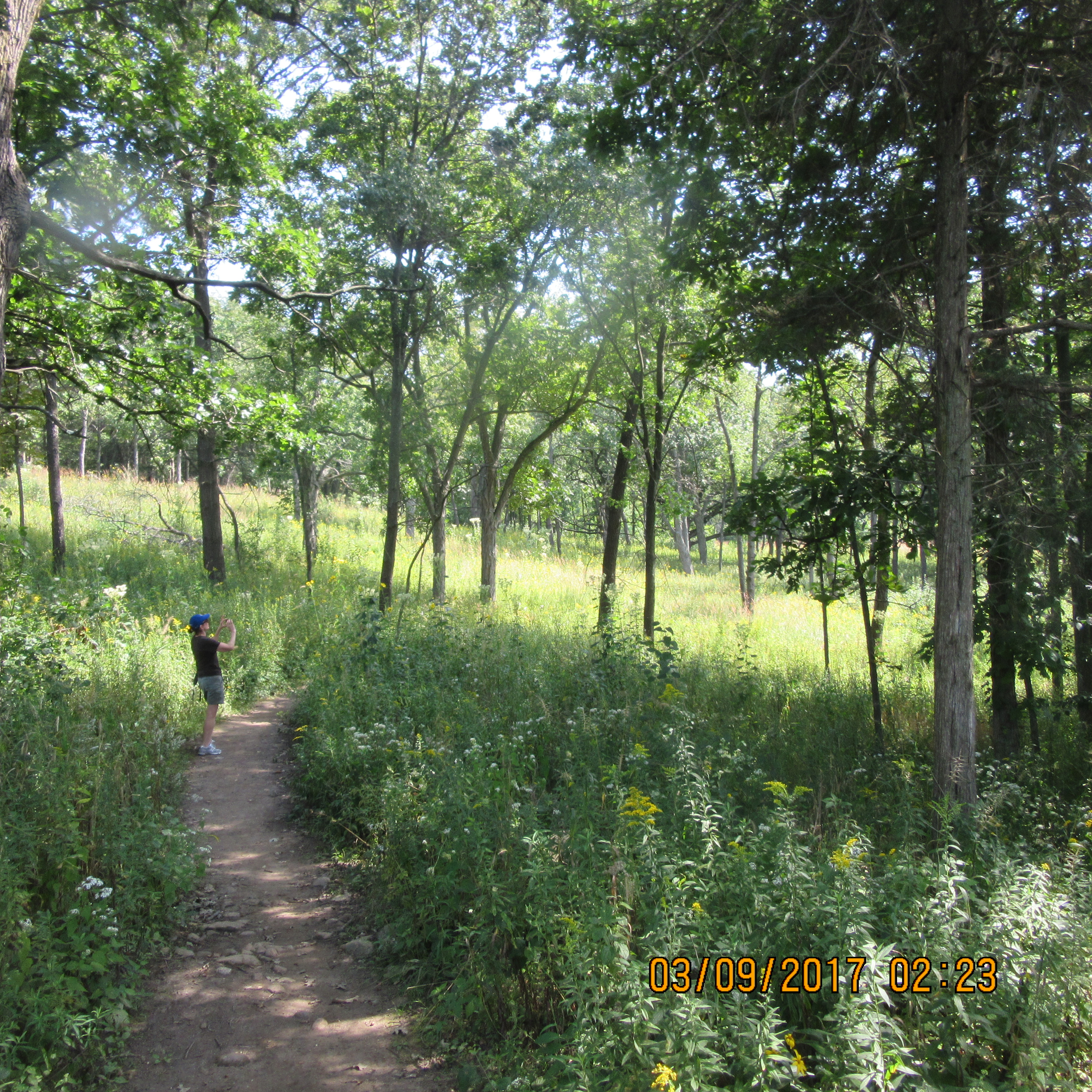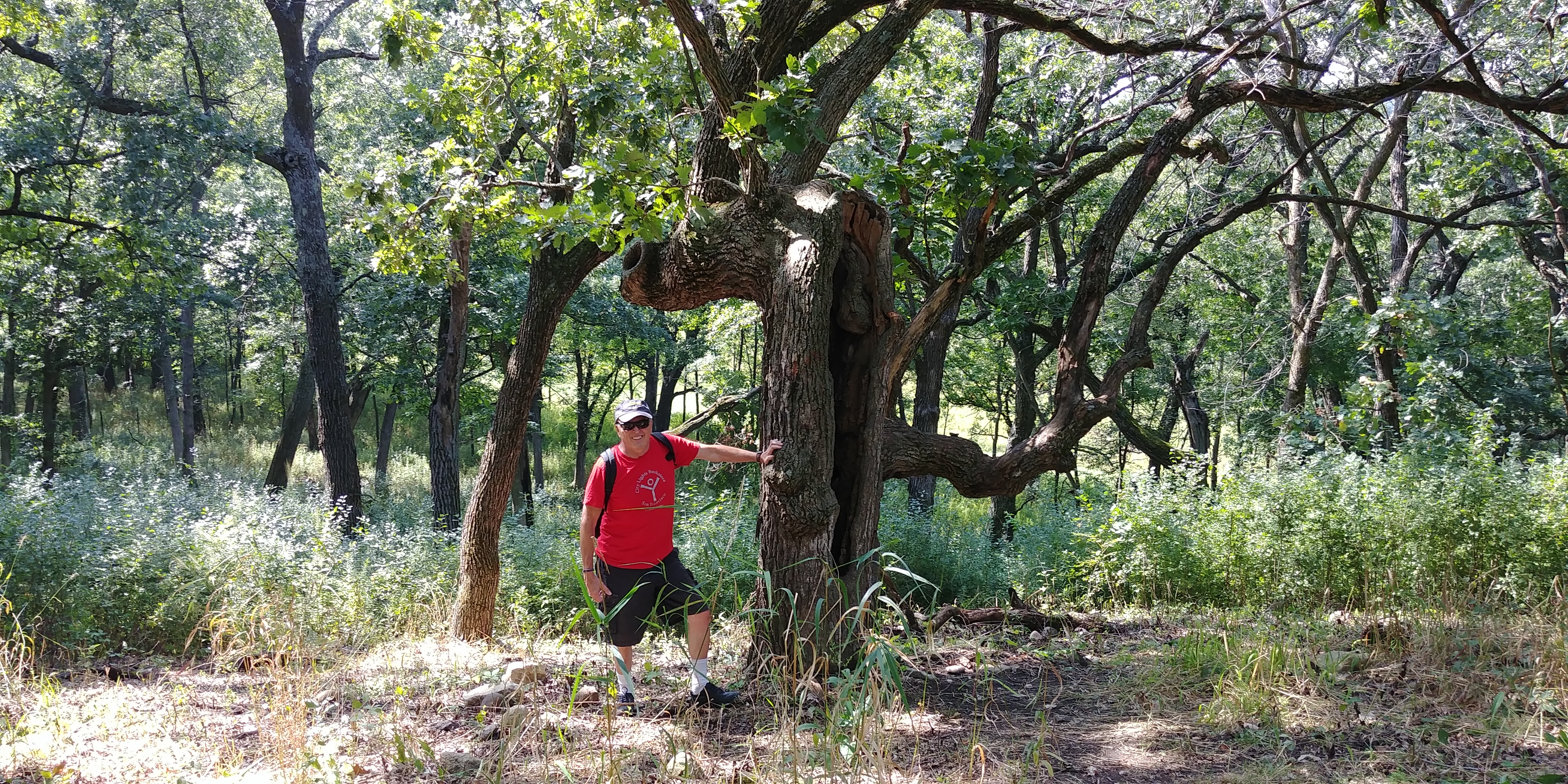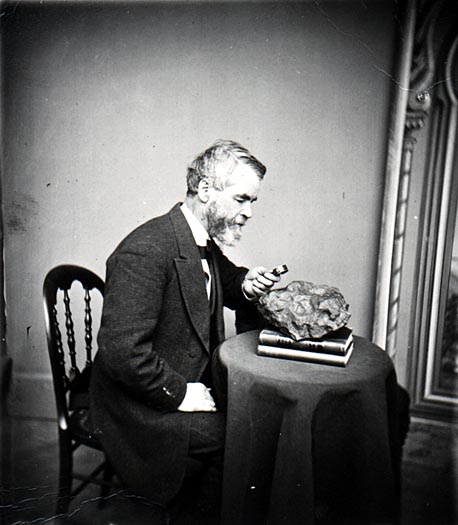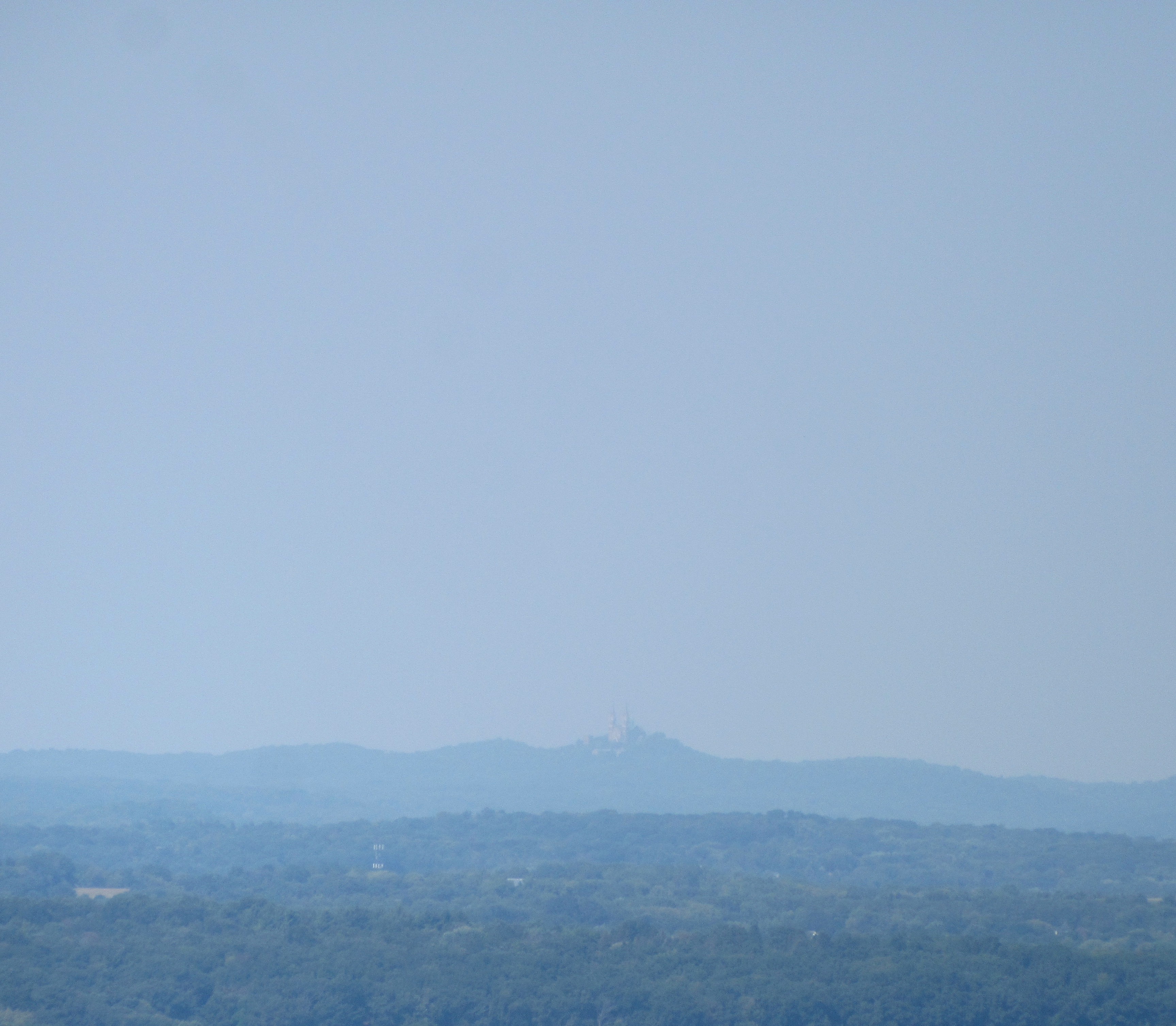
The cover photo of “North of Dixie” is by Don Hogan Charles, from Newark N.J. July 1967.
The racial profiling, physical abuse and near-murder of Seattle Seahawks star defensive lineman Michael Bennett by Las Vegas police recently demonstrates that it doesn’t matter how famous you are. If you have black skin, and especially if you’re male, you could be gunned down by the police at any time.
It’s especially resonant in Wisconsin as Bennett is the twin brother of Packer tight end Martellus Bennett (The Packers beat the Seahawks in Green Bay Sunday). Michael gained notoriety of sorts for his one-knee-on-the-ground posture during the National Anthem before Seahawks’ preseason games this year. His stance of mourning dissent was akin to Colin Kaepernick’s, and those of a handful of recent Cleveland Browns, among others. Their resistance to reflexive patriotism has eloquently and provocatively highlighted the nation’s ongoing betrayal of its exalted ideals, “the land of the free,” through pervasive systemic racism and now, a presidential administration that promotes and defends hatred and racism at most every turn.
Of course, many previously-anonymous, unarmed black men, like St. Louis’s Anthony Smith, became famous posthumously at the deadly hands of police – a disturbing recurring story. It just keeps happening over and over, which is why a longer perspective on American race relations and reform of police procedures and behaviors is urgently needed. (Please see footnote) 1
The powerful and incisive new article by Ta-Nehisi Coates in the latest Atlantic magazine provides deep and illuminating insight into the mentality and real-life effects of whiteness and white privilege, and why Donald Trump and his administration have boldly supported and advanced racist activities and policies. It’s a meaty and tough-minded read but well worth your time:
“The First White President” by Ta-Nehisi Coates
A provocative historical premise of the article undercuts the conventional wisdom that Democrats must woo back working-class whites to win again: “The myth of the virtuous white working class was made central to American identity, its sins needed to be rendered invisible. The fact was, working-class whites had been agents of racist terrorism since at least the draft riots of 1863; terrorism could not be neatly separated from the racist animus found in every class of whites.” 2
Coates’ article, with its long historical perspective on race in America, complements visual history in one of the year’s most compelling photography books, North of Dixie: Civil Rights Photography Beyond the South by Mark Speltz, a public historian from Madison. The book documents how the Civil Rights movement and racism of the 1960s extended deeply into the North (and protests went as far back into the 1930s Jim Crow era). As the book’s website notes: “Photographs inspired activists, galvanized public support, and implored local and national politicians to act, but they also provided means of surveillance and repression that were used against movement participants.” 3
Author Speltz explains that many Northern newspapers and magazines, fearful of controversy, refused to publish many of these civil rights photos, such as the one of Malcolm X below. Contextualizing them today, the photos may also give insight as to why Trump won in rust-belt states nobody expected him to win, which gained him his Electoral College victory.
You’ll also see imagery not far removed from that seen in Charlottesville, Virginia, recently the subject of profound and tragic controversy regarding white supremacists, white nationalists and Nazis. The photo below from North of Dixie looks like a shot from Charlottesville in 2017, but it’s actually counter-protesters taunting Chicago Freedom Movement marchers in 1966. It illustrates how frequently young men seem to be attracted to fascist ideology, if they are cultivated into racial hatred.
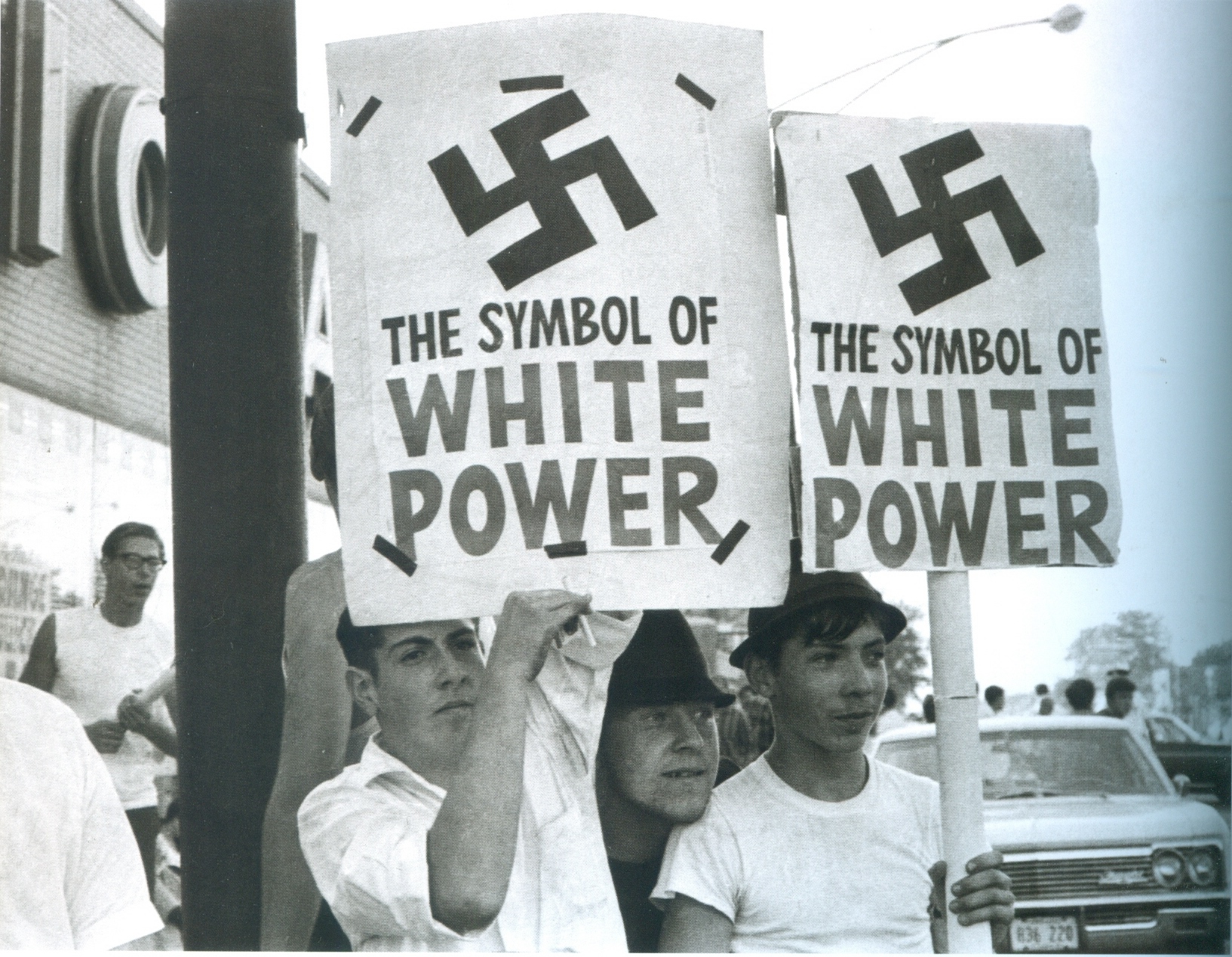
Photo by Art Shay, Chicago, Illinois 1966
The next photo below, also from Chicago, suggests how early such hatred can be developed, certainly before young people are properly educated. It underscores the crucial role of education, in terms of teaching the nation’s democratic foundation of equal treatment and opportunity espoused by the framers of the Constitution. Also one must learn of the tragedy of the Civil War fought over the South’s social and economic dependence on slavery. Sadly, the social animus – and its underlying hateful, fearful and anti-American presumptions – persist today, not only in the South.
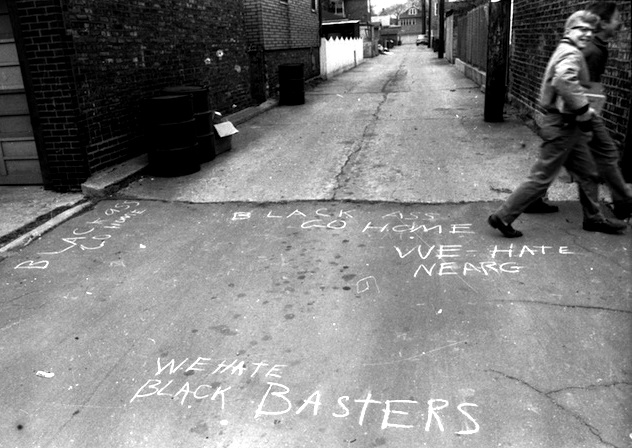
Photo by Art Shay, Chicago, Il 1966
These photos are journalism, but 1966 Shay’s alley shot has an art photo’s symbolic resonance, as it leads the eye from the nasty, illiterate pavement scrawls to the boy’s smirk, then down a deep perspective, following a zig-zagging crack into an uncertain and ominous future. That future is now, when bigotry and hate crimes have spiked dramatically since Donald Trump began his provocative, divisive presidency. But it also queries where we go from here.
The ensuing photo shows a Civil Rights protester serving a dual purpose, opposition to the Vietnam war as well as to racial hostility in America. This correlates to the intelligence and strategies behind today’s Black Lives Matter movement.
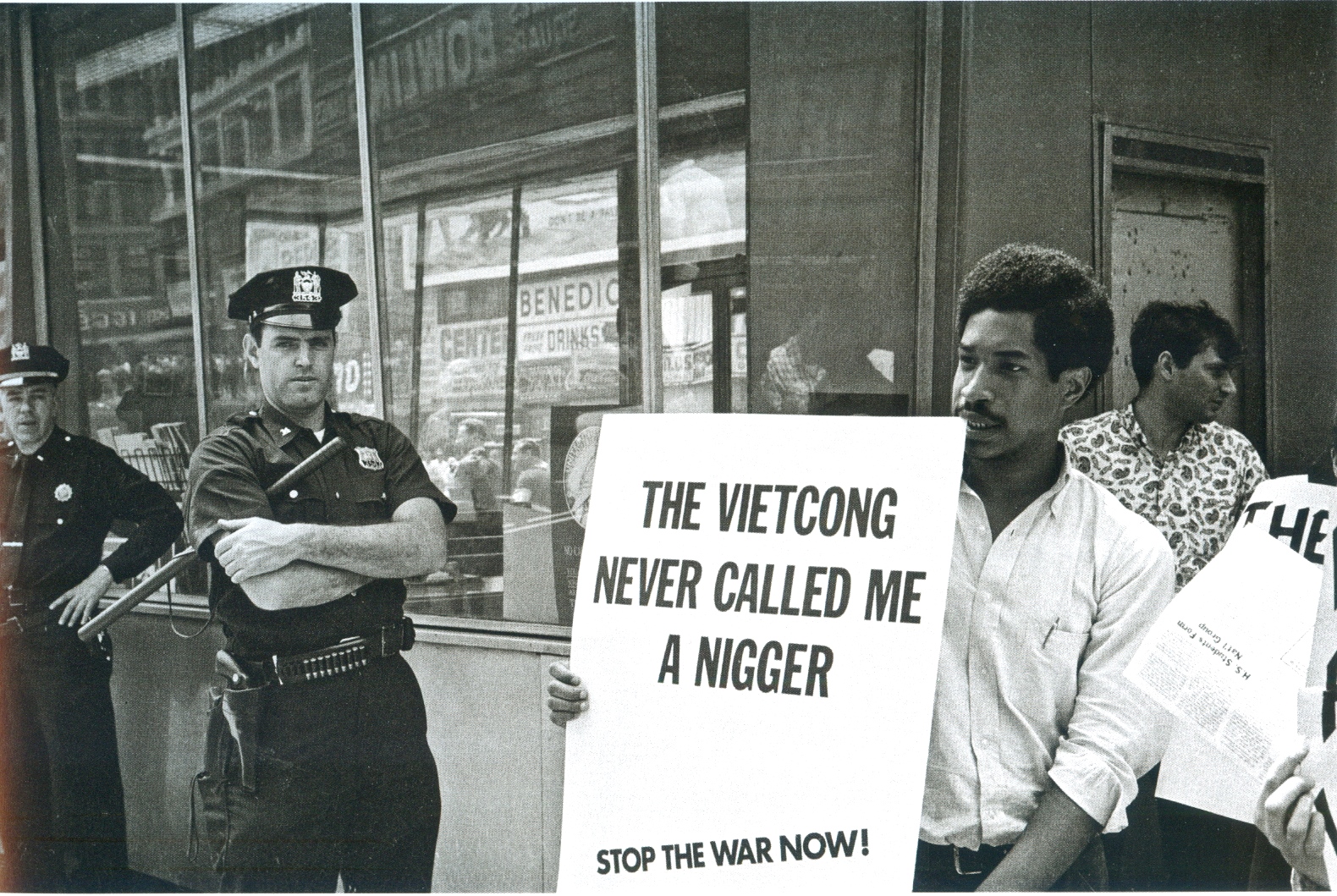
Photo by Julius Lester, New York, NY 1967
Malcolm X was the militant Civil rights leader who embraced nonviolence late in his life. Then, a black man killed him, perhaps for renouncing violence. So often, tragedy begets irony. In the photo below, Malcolm displays the Nation of Islam newspaper, with its shocking headline. This was an unpublished picture, among hundreds taken for a May 31, 1963 LIFE magazine article. Ugly reality scorched our land, but LIFE hid from racist death. Ah, but what is life if not, in its bottom line, defiance of death and injustice?
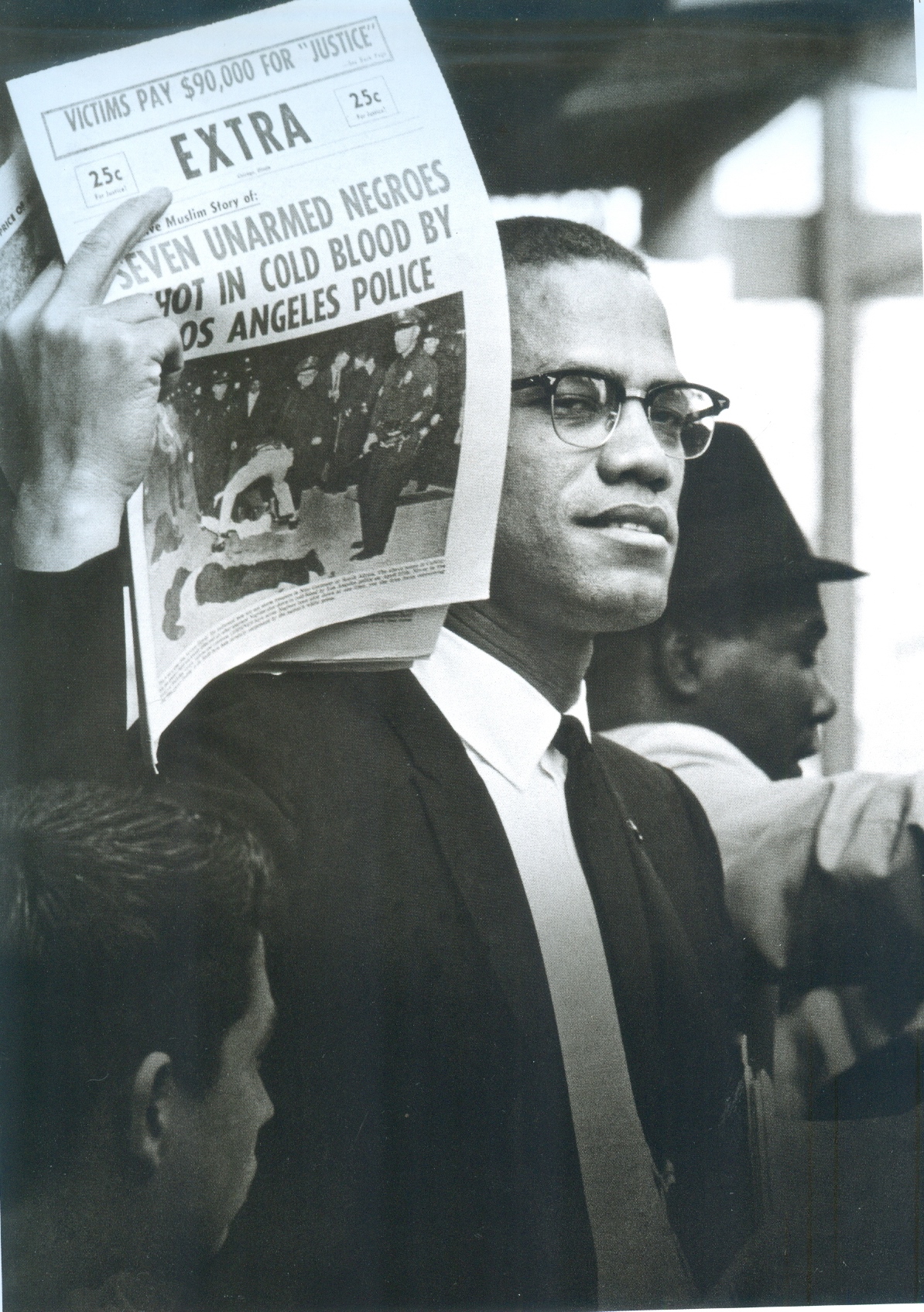
Photo of Malcolm X by Gordon Parks, Chicago, Illinois, 1963
It’s also important to remember that people on both sides of the racial divide are only human, all “sinners” as a true Christian should acknowledge, though some transgressions are worse than others, like that of Malcolm’s killer.
Let’s consider Ezekiel Elliott. Justice, ideally blind to her own biases, seems also a gagged-and-bound hostage, somewhere beneath a football stadium. Elliott, a star running back and alleged girlfriend-beater is playing this season for the Dallas Cowboys. A procedural decision by a Texas judge recently overruled the NFL’s evidently appropriate decision to suspend the African-American Elliott for the first six games of 2017 season, without pay. Regardless of those who question her motives, his ex-girlfriend Tiffany Thompson was quite evidently abused and beaten by Elliott multiple times in 2016 – as photos of her show – right before the Cowboys drafted him. Since being charged, he also forcefully exposed the breasts of another woman in public, not having learned much, it seems. The Cowboys have a history of ignoring some of the worst behavior of football players, if they think they can squeeze out some wins by hiring them. A bit like the blind loyalty of some Trump supporters, it’s a sad commentary that the Cowboys remain “America’s team” with by far the NFL’s leading profits of fan sales of team merchandise.
The league, to its credit, finally listened to a woman seriously, and will continue to pursue this case. For his many faults, NFL commissioner Roger Goodell shows he can learn and change. So, one hopes, justice has her day.
But Elliott is the African-American exception, having won a large measure of privilege that he’s apparently abused as well. By contrast, Civil Rights activists have been peaceful, strong-backed, but largely non-violent, unless the police or counter-protesters get physical or worse, as Speltz’s important book shows.
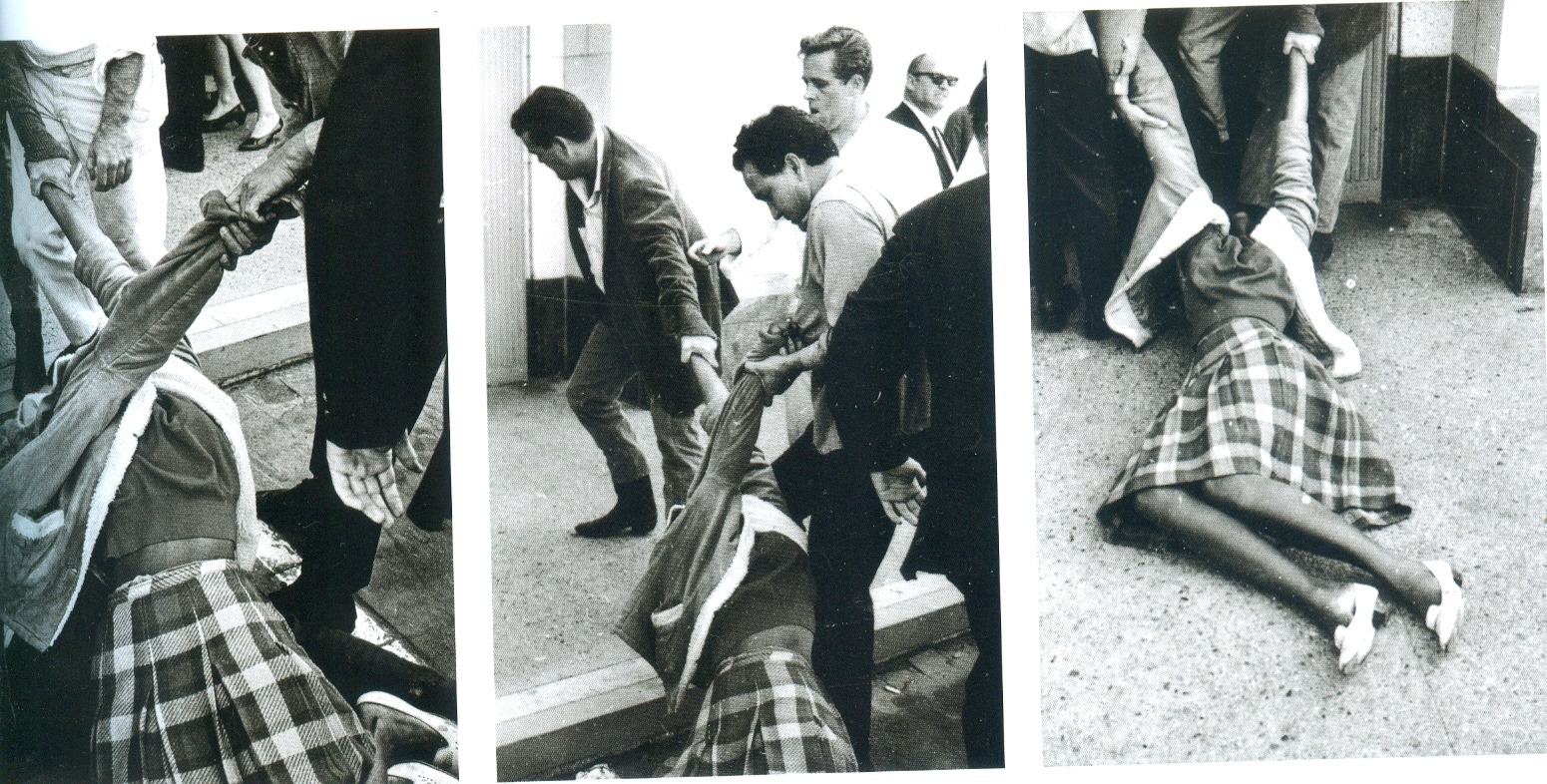
Photos by Charles Brittin, Los Angeles, CA 1965
The next photos (above) by Charles Brittin show that police tactics were not much different back in the 1960s, as we see a black woman In Los Angeles in March 1965 being brutally removed from a peaceful non-violent site protesting the shocking violence in Selma, earlier that month.
The shot below by Julian Wilson graphically Illustrates the courage of non-violent protesters, risking being buried alive in hopes of stopping construction of a new school that would further segregate neighborhood schools. The image also hauntingly recalls the burial of exterminated Jews by Nazis during the Holocaust. 4
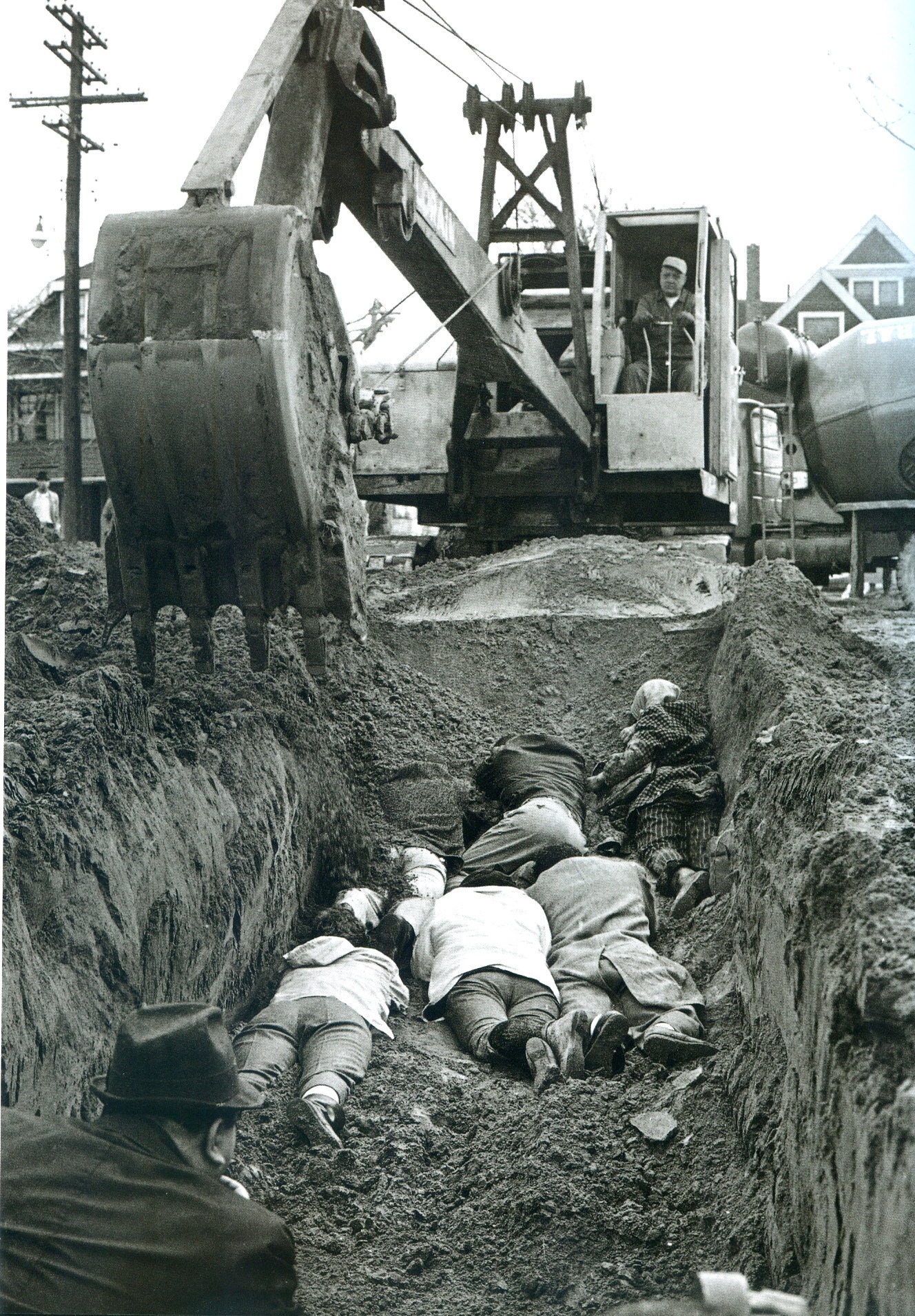
Photo by Julian C. Wilson, Cleveland, OH April 1964
This daring sort of act may have inspired “Tank Man,” (below, photo not from North of Dixie) a single anonymous protester at Tiananmen Square in 1989. He stopped the Communist Chinese government tanks in their tracks by simply standing up to them, part of a student-led protest demanding freedom of speech, freedom of the press and government accountability. The protests were forcibly suppressed after the government declared martial law. In what became known in the West as the Tiananmen Square Massacre, troops with assault rifles and tanks killed at least several hundred demonstrators trying to block the military’s advance towards Tiananmen Square.

Photo of “Tank Man” in Tiananmen Square, June, 1989, by Jeff Widener Associated Press (not in “North of Dixie”)
North of Dixie also covers one of the most subtly pernicious and far-reaching aspects of systemic racism: redlining or housing discrimination. My own hometown of Milwaukee – to this day one of the most segregated cities in America – became a fair-housing hotbed, especially when the iconoclastic Catholic priest James Groppi began leading the fight against housing discrimination. Groppi – whom I was fortunate enough to have studied religion with as a young elementary school student – was an inspirational and hard-headed figure. I’m sure he helped inspire me to later do fair-housing testing: going to homes for sale posing as a prospective home buyer with a black female partner. (A 2017 independent report on the Milwaukee police procedures and policies, requested by the police chief, found the department sorely lacking in its relations with, and profiling of, the minority populations it ostensibly serves.)
In the North of Dixie photo below, Groppi stands with two other pioneers, Milwaukee’s first black alderwoman Vel Phillips, and (at left, in the white hat), comedian and social activist Dick Gregory, who recently died, but not before publishing a powerfully provocative book of his own, Defining Moments in Black History: Reading Between the Lies. But here, one can palpably feel the resolute determination in both Groppi and Gregory’s faces, as they gaze at a challenge beyond, perhaps taunting counter-demonstrators, or bearing the weight of Frederick Douglass’ famous dictum, “if there is no struggle, there is no progress.”
Dick Gregory, Father James Groppi and Ald. Vel Phillips. Unknown Photographer, Milwaukee WI, Sept. 1967, from “North of Dixie: Civil Rights Photography Beyond the South.”
I can’t wait to read Gregory’s new book, but he has been on my radar as an author ever since I bought his first book From the Back of the Bus in the early ’60s. It was a collection of his stand-up observations, which included pithy posed photos of Gregory illustrating some of his gags and points, and it came two years before his better-known 1964 autobiography Nigger.
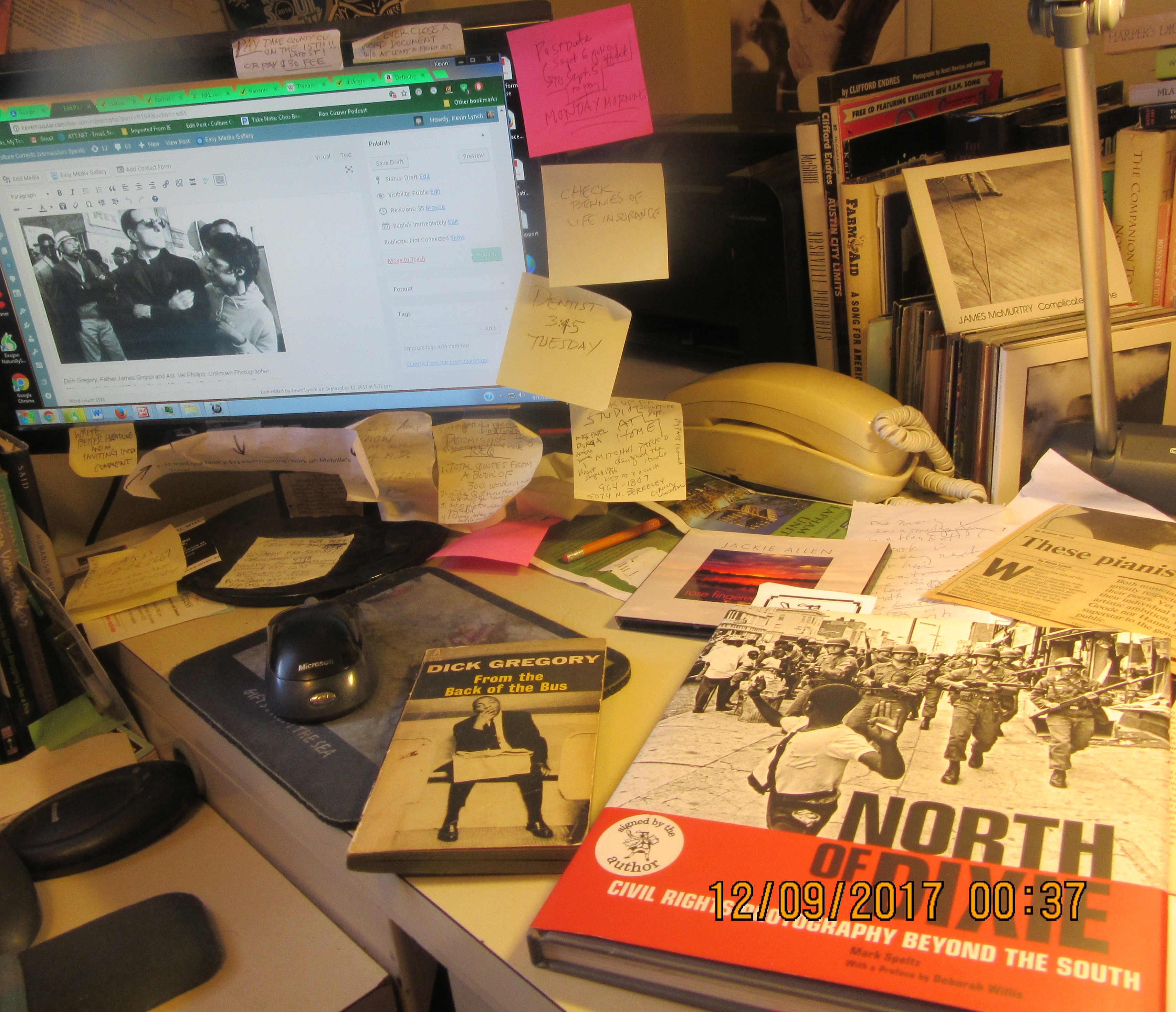
Dick Gregory’s 1962 photo-illustrated book “From the Back of the Bus” helped open my young eyes and mind to Civil Rights, and Gregory himself is a subject in Mark Speltz’s new photo documentary book “North of Dixie.” Photo by Kevin Lynch
A telling Gregory comment in From Back of the Bus addresses Northern redlining of real estate: “Down South, they don’t care how close I get as long as I don’t get too big; and up North, they don’t care how big I get as long as I don’t get too close.” 5
The final photo I’ll share from Mark Speltz’s North of Dixie book shows the human side of the controversial Black Panthers, a militant civil rights activist group of the era. The Panthers did resort to violence at times, by the dictum of “by any means necessary” for racial justice. However, FBI director J. Edgar Hoover effectively demonized them whole-cloth. In the photo below, we see Panther Charles Bursey serving breakfast to a child in Oakland, California. The Panthers raised enough funds and resources to help feed numerous neighborhood children and families throughout the United States.
This brings us forward to the next steps for The Black Lives Matter movement and the implicit query of all these photos: Will we learn, from the history laid bare in this book, that racism’s poisoning and coagulation of the American spirit infected the North as well as the South? BLM is now forming new initiatives – The Electoral Justice Project and The Black Futures Lab – which, they say, will address black voter alienation and transform the ways that African-American communities participate in the 2018 election and beyond, as reported by Dani McClain in “The Future of BLM” in The Nation. 6
In this age of increasingly visually-oriented information and learning, a book like North of Dixie takes us to the heart of our greatest and oldest struggle as a nation, something that Northerners as well as Southerners must own, and help overcome together. The road ahead, like Art Shay’s 1966 photo above, may feel like a defaced, cracked back alley, with misguided youth headed in the wrong direction. But the greater mass of millennials cry out for a more just and equal America. We press ahead in search of our nation’s spiritual replenishment and deliverance. Imagine the day when a Black Panther’s photo might symbolize that dream, no longer deferred.
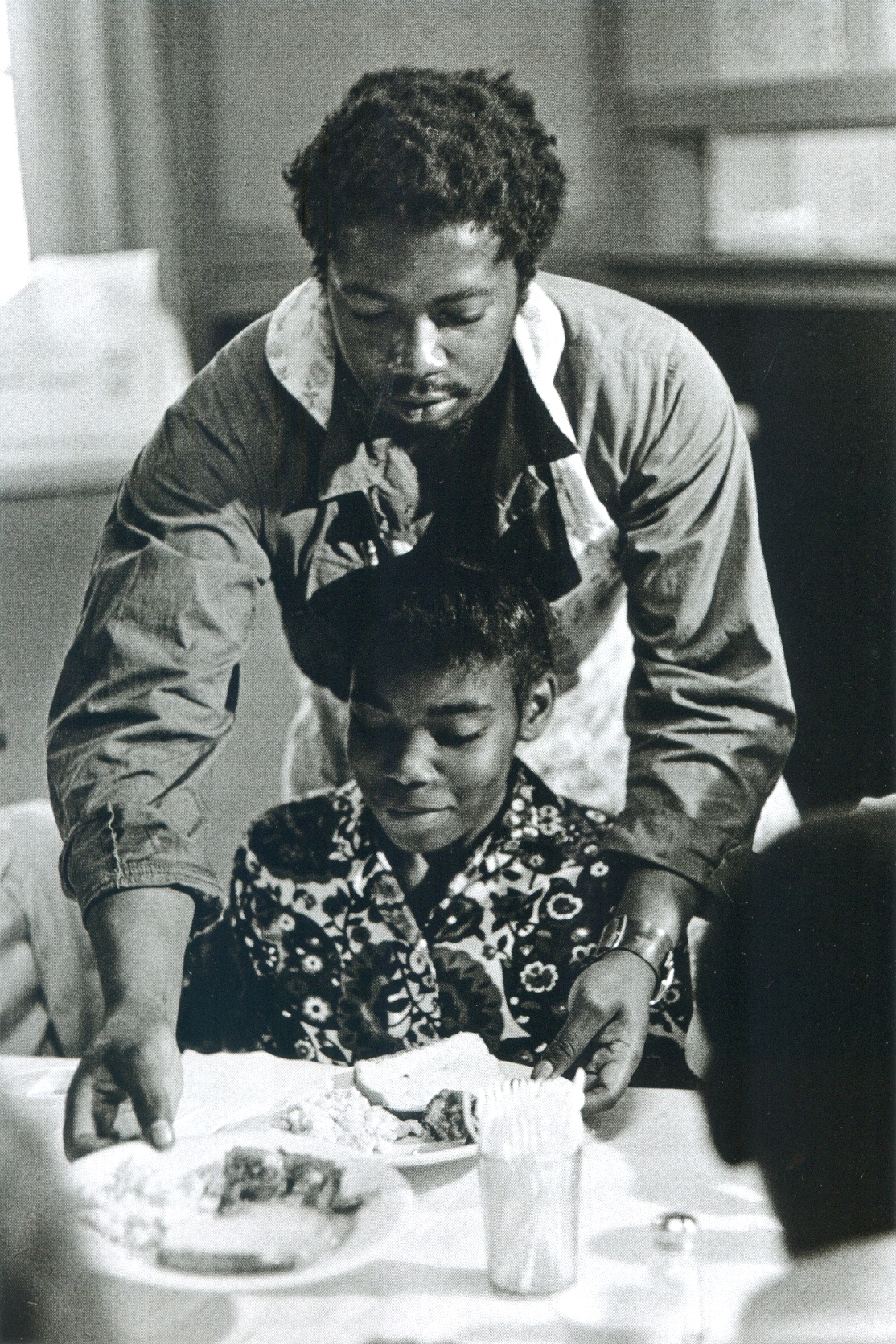
Photo of Black Panther Charles Bursey by Ruth-Marion Baruch, Oakland, California, 1969
__________
-
The same Fascists who were behind the exile (and extermination) of Jews in Nazi Germany are the ancestors of our present day Nazis and white supremacist. The exile of 800,000 of our children is red meat for the Fascists. They can’t be allowed to get away with it.”
A group of 7,000 Jewish people expelled from Germany by the German Nazi authorities and living in Zbaszyn on the Polish-German border, 3rd November…GETTYIMAGES.COM5.. Dick Gregory, From the Back of the Bus, Avon, 1962, 646. “The Future of BLM,” cover story by Dani McClain, The Nation, Oct 9, 2017, 14



 Lapham Peak Unit of the Kettle Moraine State Forest is sort of legendary among state parks and locations in Wisconsin, a place of stunning beauty, of rich physical interaction with nature as a hiker, biker, skiier or picnicker, and a place of magnificence and romance.
Lapham Peak Unit of the Kettle Moraine State Forest is sort of legendary among state parks and locations in Wisconsin, a place of stunning beauty, of rich physical interaction with nature as a hiker, biker, skiier or picnicker, and a place of magnificence and romance.